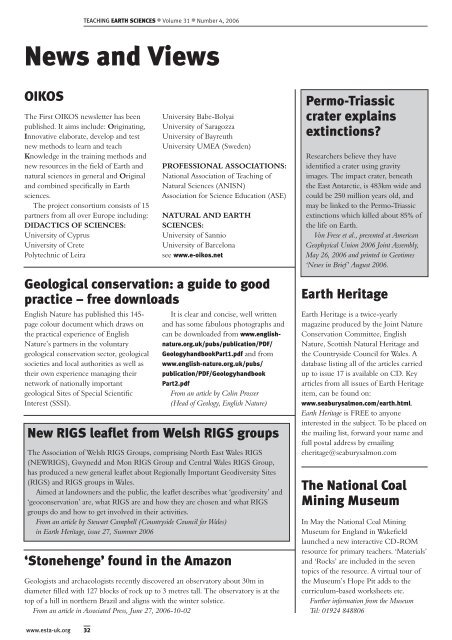teaching - Earth Science Teachers' Association
teaching - Earth Science Teachers' Association
teaching - Earth Science Teachers' Association
You also want an ePaper? Increase the reach of your titles
YUMPU automatically turns print PDFs into web optimized ePapers that Google loves.
TEACHING EARTH SCIENCES ● Volume 31 ● Number 4, 2006<br />
News and Views<br />
OIKOS<br />
The First OIKOS newsletter has been<br />
published. It aims include: Originating,<br />
Innovative elaborate, develop and test<br />
new methods to learn and teach<br />
Knowledge in the training methods and<br />
new resources in the field of <strong>Earth</strong> and<br />
natural sciences in general and Original<br />
and combined specifically in <strong>Earth</strong><br />
sciences.<br />
The project consortium consists of 15<br />
partners from all over Europe including:<br />
DIDACTICS OF SCIENCES:<br />
University of Cyprus<br />
University of Crete<br />
Polytechnic of Leira<br />
University Babe-Bolyai<br />
University of Saragozza<br />
University of Bayreuth<br />
University UMEA (Sweden)<br />
PROFESSIONAL ASSOCIATIONS:<br />
National <strong>Association</strong> of Teaching of<br />
Natural <strong>Science</strong>s (ANISN)<br />
<strong>Association</strong> for <strong>Science</strong> Education (ASE)<br />
NATURAL AND EARTH<br />
SCIENCES:<br />
University of Sannio<br />
University of Barcelona<br />
see www.e-oikos.net<br />
Permo-Triassic<br />
crater explains<br />
extinctions?<br />
Researchers believe they have<br />
identified a crater using gravity<br />
images. The impact crater, beneath<br />
the East Antarctic, is 483km wide and<br />
could be 250 million years old, and<br />
may be linked to the Permo-Triassic<br />
extinctions which killed about 85% of<br />
the life on <strong>Earth</strong>.<br />
Von Frese et al., presented at American<br />
Geophysical Union 2006 Joint Assembly,<br />
May 26, 2006 and printed in Geotimes<br />
‘News in Brief ’ August 2006.<br />
Geological conservation: a guide to good<br />
practice – free downloads<br />
English Nature has published this 145-<br />
page colour document which draws on<br />
the practical experience of English<br />
Nature’s partners in the voluntary<br />
geological conservation sector, geological<br />
societies and local authorities as well as<br />
their own experience managing their<br />
network of nationally important<br />
geological Sites of Special Scientific<br />
Interest (SSSI).<br />
It is clear and concise, well written<br />
and has some fabulous photographs and<br />
can be downloaded from www.englishnature.org.uk/pubs/publication/PDF/<br />
GeologyhandbookPart1.pdf and from<br />
www.english-nature.org.uk/pubs/<br />
publication/PDF/Geologyhandbook<br />
Part2.pdf<br />
From an article by Colin Prosser<br />
(Head of Geology, English Nature)<br />
New RIGS leaflet from Welsh RIGS groups<br />
The <strong>Association</strong> of Welsh RIGS Groups, comprising North East Wales RIGS<br />
(NEWRIGS), Gwynedd and Mon RIGS Group and Central Wales RIGS Group,<br />
has produced a new general leaflet about Regionally Important Geodiversity Sites<br />
(RIGS) and RIGS groups in Wales.<br />
Aimed at landowners and the public, the leaflet describes what ‘geodiversity’ and<br />
‘geoconservation’ are, what RIGS are and how they are chosen and what RIGS<br />
groups do and how to get involved in their activities.<br />
From an article by Stewart Campbell (Countryside Council for Wales)<br />
in <strong>Earth</strong> Heritage, issue 27, Summer 2006<br />
‘Stonehenge’ found in the Amazon<br />
Geologists and archaeologists recently discovered an observatory about 30m in<br />
diameter filled with 127 blocks of rock up to 3 metres tall. The observatory is at the<br />
top of a hill in northern Brazil and aligns with the winter solstice.<br />
From an article in Associated Press, June 27, 2006-10-02<br />
<strong>Earth</strong> Heritage<br />
<strong>Earth</strong> Heritage is a twice-yearly<br />
magazine produced by the Joint Nature<br />
Conservation Committee, English<br />
Nature, Scottish Natural Heritage and<br />
the Countryside Council for Wales. A<br />
database listing all of the articles carried<br />
up to issue 17 is available on CD. Key<br />
articles from all issues of <strong>Earth</strong> Heritage<br />
item, can be found on:<br />
www.seaburysalmon.com/earth.html.<br />
<strong>Earth</strong> Heritage is FREE to anyone<br />
interested in the subject. To be placed on<br />
the mailing list, forward your name and<br />
full postal address by emailing<br />
eheritage@seaburysalmon.com<br />
The National Coal<br />
Mining Museum<br />
In May the National Coal Mining<br />
Museum for England in Wakefield<br />
launched a new interactive CD-ROM<br />
resource for primary teachers. ‘Materials’<br />
and ‘Rocks’ are included in the seven<br />
topics of the resource. A virtual tour of<br />
the Museum’s Hope Pit adds to the<br />
curriculum-based worksheets etc.<br />
Further information from the Museum<br />
Tel: 01924 848806<br />
www.esta-uk.org<br />
32

















